Cocking a crossbow is a fundamental skill that every crossbow enthusiast, hunter, or target shooter should master. Whether you’re a novice or an experienced crossbow user, understanding the proper techniques for cocking your crossbow safely and effectively is essential for accuracy and safety.
A well-cocked crossbow ensures that your shots are consistent and precise, delivering the desired results in both hunting and competitive shooting scenarios. However, the process can vary depending on the type of crossbow you own, so it’s crucial to familiarize yourself with your specific crossbow’s cocking mechanism and follow manufacturer guidelines.
In this guide, we will walk you through the essential steps and techniques required to correctly cock various types of crossbows, emphasizing safety precautions and best practices to help you become a skilled crossbow user. Whether you’re a beginner looking to learn the basics or an experienced archer seeking to refine your skills, this comprehensive guide will provide you with the knowledge and confidence to properly cock your crossbow and improve your shooting accuracy. So, let’s begin and discover the art of cocking a crossbow.
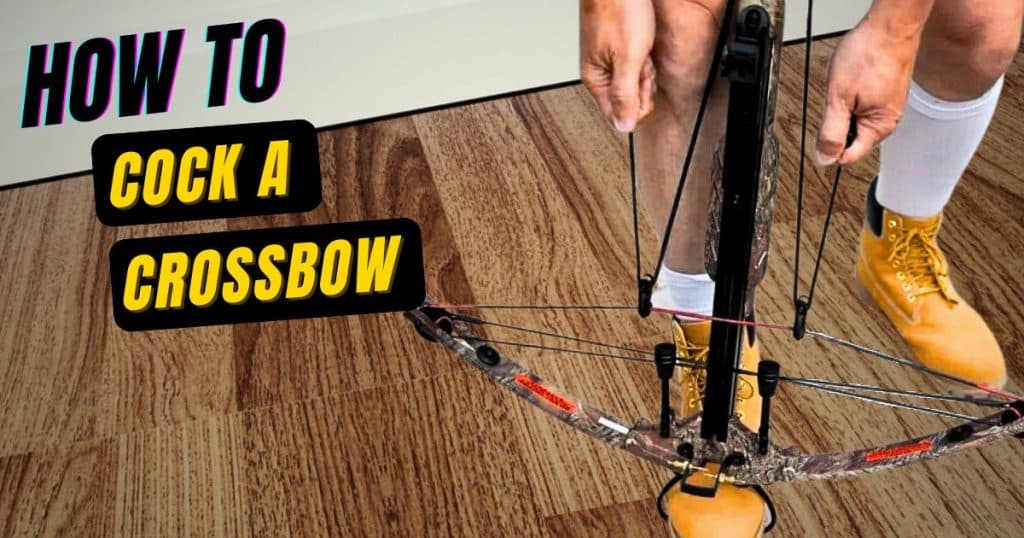
Different Types Of Cocking Mechanisms Of Crossbows
Before delving into the art of cocking, it’s important to understand that there are different types of crossbows. The type you have may influence the method you use for cocking. Some common types include recurve crossbows, compound crossbows, and reverse-draw crossbows.
Crossbows provide a range of cocking mechanisms, each accompanied by its unique benefits and drawbacks. These diverse cocking methods encompass manual cocking, rope cocking devices, and crank cocking devices. The selection of a specific mechanism frequently hinges on an individual’s physical strength, experience level, and the specific type of crossbow they are using.
When it comes to choosing a suitable cocking mechanism, it’s essential to consider individual factors. For instance, individuals with greater physical strength may opt for manual cocking, which requires a more hands-on approach but provides a sense of control. On the other hand, those seeking a more convenient and user-friendly option may lean towards rope cocking devices or crank cocking devices, which offer mechanical assistance in drawing the crossbow.

Moreover, the choice of cocking mechanism can also be influenced by the type of crossbow in use. In today’s market, many modern crossbows, including those crossbows available at affordable price points under $500 or even some models under $300, are designed with integrated cocking systems. These integrated systems serve to streamline the cocking process, offering users a hassle-free experience.
Manual Cocking:
This is the simplest form of cocking, where the shooter uses their own physical strength to draw the string back into the firing position. It can be challenging, especially with high draw weight crossbows, and may require additional tools like cocking aids or cranks to make it easier.
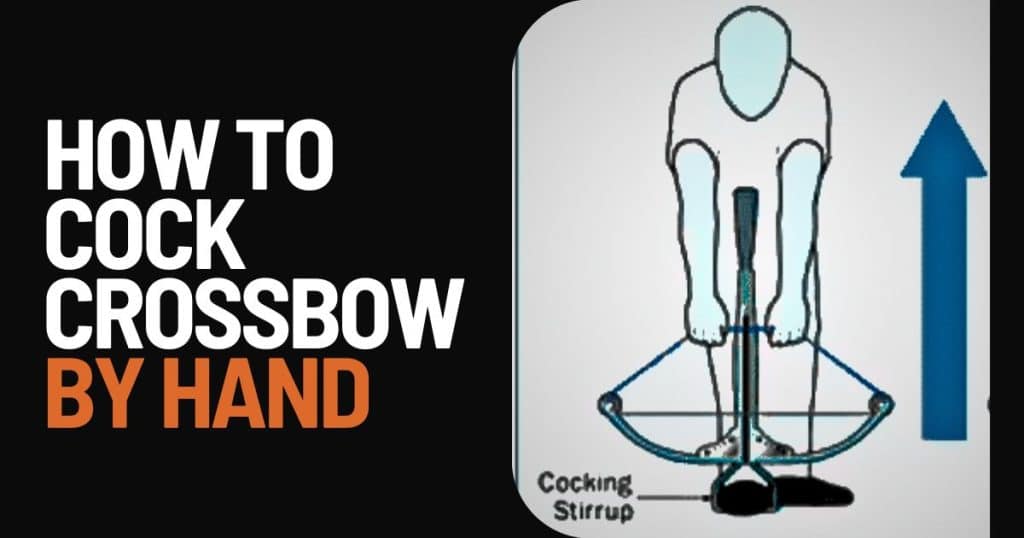
Rope Cocking Device:
A rope cocker consists of two handles connected by a rope. The shooter places the handles on the string and uses the mechanical advantage of the rope to draw the string back evenly. It’s a common and relatively easy-to-use method that reduces the effort required to cock the crossbow.
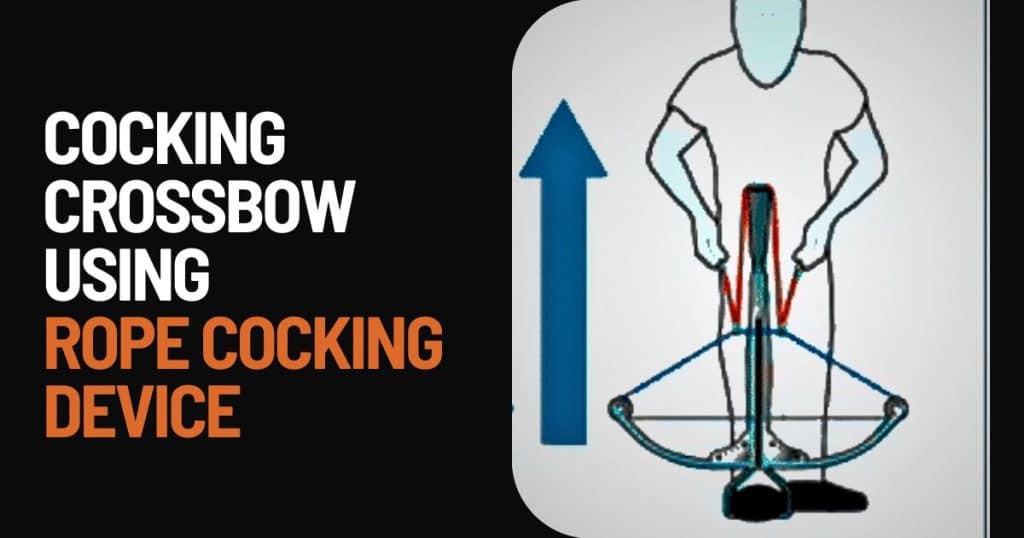
Crank Cocking Device:
Crank cocking devices are mechanical systems that use a crank or winch to draw the crossbow’s string. They provide a consistent and controlled draw and are especially helpful for individuals with limited upper body strength. Some crossbows come with built-in crank mechanisms, while others offer them as optional accessories.
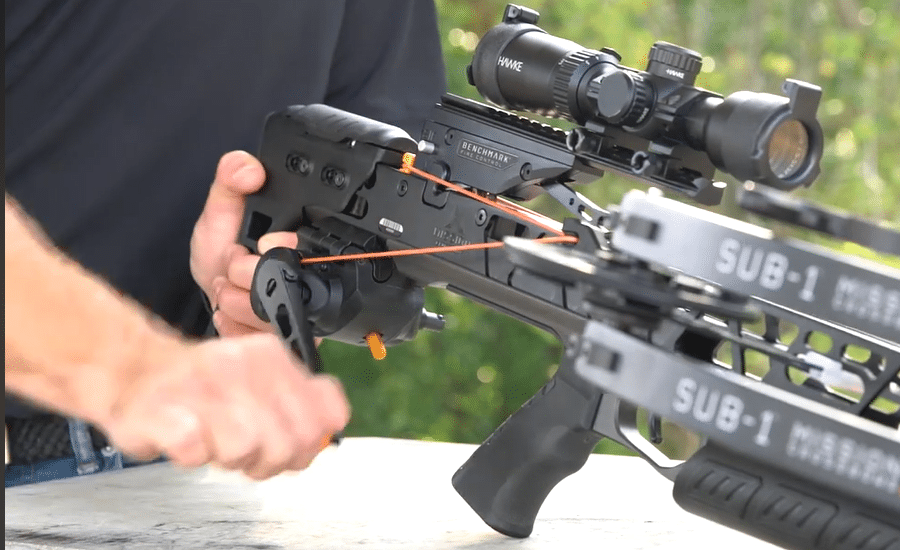
Safety Precautions Before Cocking A Crossbow
Safety should always be the top priority when handling a crossbow. Before we dive into the cocking process, let’s go over some essential safety precautions:
- Always Treat it Like a Firearm and Loaded: Always handle your crossbow as if it were loaded and ready to fire. Keep it pointed in a safe direction at all times, just as you would with a firearm.
- Check Your Crossbow: Regularly inspect your crossbow for any signs of damage or wear.
- Use Protective Gear: Wear appropriate safety gear, including eye protection and a crossbow-rated glove.
- Clear Shooting Lane: Ensure there are no obstructions or people in your shooting path.
- Be Aware Of Broadheads users: If you’re using bolts with broadheads, be cautious not to accidentally nick or cut your bowstring or your hand with the sharp blades.
- Cocking Rope Placement: After cocking your crossbow, avoid wearing the cocking rope around your neck, as it could become entangled with the bowstring during a shot.
- Rope Length Adjustment: Many cocking ropes are adjustable. Customize the length to match your crossbow so that you don’t have to exert unnecessary force when cocking.
How To Cock A Crossbow Correctly Like A Pro
Step-by-Step Guide: What Should You Do When Cocking A Crossbow
Now, let’s get into the nitty-gritty of cocking a crossbow. Follow these steps for a safe and effective cocking process:
Step 1: Prioritize Safety
We assume you have already read the safety precautions we discussed above, but we want to emphasize once more that safety should always be your top priority when dealing with crossbows. Before you begin, ensure that you have a clear shooting range, and make sure the crossbow is pointing in a safe direction. Keep the crossbow on safety mode until you are absolutely ready to fire.
Step 2: Proper Foot Placement
Begin by positioning your crossbow on a stable surface, and if your crossbow has a stirrup at the front, place your foot in it. This not only provides stability but also keeps the crossbow securely in place.
Step 3: Secure Grip
Always maintain a firm and hands-free grip on the crossbow to prevent accidental misfires.
Step 4: Select Your Cocking Method
Choose the cocking method that suits your crossbow and physical capabilities. This could involve using a rope cocking device, a crank, or other tools designed for your specific crossbow model.
Step 5: Attach a Cocking Aid (If Applicable)
If you’re using a rope or crank cocking device, securely attach it to your crossbow following the manufacturer’s instructions.
Step 6: Position Yourself Correctly
Stand behind the crossbow with your body properly aligned. Keep your feet shoulder-width apart to maintain stability during the process.
Step 7: Engage the Cocking Device
If using a rope cocking device, place your foot in the stirrup and pull the ropes or handles evenly to cock the crossbow. Continue pulling the handles upward until the crossbow string is fully cocked. You’ll usually hear a distinct click when it’s fully cocked.
For crank cocking devices, locate the attachment points on your crossbow where the crank cocking device connects. These attachment points are usually located near the rear of the crossbow, where the string is housed.
Rotate the crank until it engages with the crossbow’s string. This typically involves inserting the crank handle into a socket on the crossbow’s stock and turning it until it clicks into place. Make sure it’s securely connected.
Hold the crank handle firmly and begin turning it in the direction indicated by the manufacturer’s instructions. Most crank cocking devices have a built-in gearing system that makes it easier to draw the crossbow string. Continue cranking until the crossbow string is fully cocked. You’ll usually hear a distinct click when it’s fully cocked.
Step 8: Verify Alignment
Check that the string is fully and evenly drawn back, and make sure the safety mechanism remains engaged.
Step 9: Loading the Bolt
Now that your crossbow is safely cocked, it’s time to load a bolt (arrow).
- Pick up the bolt near its front end, avoiding the rear part where the string interacts. This prevents your fingers from coming into contact with the string if the crossbow were to accidentally fire.
- Identify the off-colored fletching on your bolt, which should be pointing straight down into the shooting rail.
- Gently slide the bolt back until the nock engages with the string.
- Keep your hand away from the rear of the bolt and the bowstring to avoid potential injuries if an accidental firing were to occur.
Step 10: Disengage the Safety
Carefully disengage the safety mechanism or safety switch, preparing the crossbow for firing.
Step 11: Take Aim and Shoot
Align your sights or scope with the target, and squeeze the trigger gently.
Step 12: Re-engage the Safety
After shooting, immediately re-engage the safety mechanism.
Once you have finished shooting, follow the proper procedure for decocking your crossbow.
By following these comprehensive steps, you’ll ensure that you cock your crossbow safely and efficiently, setting the stage for a successful shot. Remember to always prioritize safety and adhere to the specific instructions for your crossbow model.
Incorrect Crossbow Cocking Methods to Avoid
The incorrect methods of cocking a crossbow include cocking unevenly, dry-firing, and not cocking the string evenly. These methods can lead to damage or injuries in several ways:
- Cocking unevenly: If the string is not centered into the latch evenly, it can lead to dry-firing. Dry-firing occurs when the energy stored in the limbs is not transferred properly to the bolt. This can cause major damage to the limbs and result in the bow exploding. Cocking unevenly can also create undesired vibrations, possibly causing cracks in the limbs and leading to their breakage.
- Dry-firing: Dry-firing happens when the crossbow is fired without a bolt loaded. This can happen if the string is not properly cocked or if the safety is not engaged. Dry-firing can cause damage to the slider, rails, limbs, and bowstring. It can also result in the bow exploding, which can be extremely dangerous.
- Not cocking the string evenly: Cocking the string unevenly means that there is an imbalance of pressure in the limbs. This can result in inconsistent accuracy and performance of the crossbow. It is important to cock the string evenly to ensure that both limbs have the same amount of pressure.
It is crucial to follow the correct cocking methods and techniques to avoid damage to the crossbow and potential injuries to yourself and others.
Crossbow Cocking Tips
Here are a few tips for cocking a crossbow:
Maintain consistent string placement:
Whether you are manually cocking or utilizing a cocking device, it is crucial to maintain the string in a consistently centered trigger-latch position during each cocking process. To aid in achieving this consistency, you can mark the string on both sides of the rail with a marker. This visual cue will serve as a reference point for a properly centered string placement, ultimately contributing to consistent accuracy.
Keep the front end pointed in a safe direction:
It is imperative to ensure that the front end of the crossbow is consistently pointed in a safe downrange direction while cocking, even if there is no arrow loaded. This precaution is taken to prevent accidental dry fires and prioritize safety.
Use the ball of your foot in the stirrup:
When manually cocking a crossbow, placing the ball of your foot in the stirrup will help prevent slippage while cocking.
Follow manufacturer instructions:
It is important to consult your crossbow manual to understand the specific cocking procedure for your model. Some crossbows may require manual engagement of the safety before cocking, while others may engage the safety automatically.
Essential Don’ts for Cocking with Confidence
Here are the things you must NOT do while cocking a crossbow:
- Do Not Hand Cock Unnecessarily: Avoid hand cocking the crossbow unless you are experienced and comfortable with it, as it can lead to physical strain and repetitive strain injuries.
- Do Not Neglect Crossbow Inspection: Never ignore the condition of your crossbow. Before cocking, inspect the limbs for cracks, check for loose bolts, and ensure there are no cracks or twisting in the limbs. Also, carefully examine the bowstring for wear or separation.
- Do Not Use Rope Cocking on Incompatible Crossbows: Avoid using a rope cocking device on reverse draw limb crossbows, as they are not designed for hand-drawing, and attempting to do so may result in finger injuries.
- Do Not Disengage Safety Prematurely: Never switch off the safety of the crossbow unless you have an arrow properly mounted in the shooting position and are ready to shoot.
- Do Not Cock Off-Center: It is essential to cock the crossbow in a straight and centered manner on every occasion. Make sure the serving is perfectly aligned at the center, ensuring equal lengths on both sides of the rail. Cocking the crossbow off-center, even by a slight margin, can lead to considerable inaccuracies in your bolt’s trajectory, causing it to miss the intended target.
- Do Not Point Crossbow Unsafely: Maintain the crossbow in a safe direction, always pointed downrange while cocking.
- Do Not Ignore String Placement: Keep string placement consistent by marking the string and rail for visual cues.
- Avoid Cocking Without Devices (if possible): It’s preferable to use a cocking device to ensure consistent and easier cocking. If manually cocking, be mindful of the physical effort required and take care to avoid strain or injury.
- Do Not Disregard Manufacturer’s Instructions: Always follow the manufacturer’s instructions regarding engaging the safety before and after cocking.
- Do Not Overlook Gear Inspection: Never skip inspecting your crossbow and arrows for any signs of damage or wear before cocking.
- Avoid Premature Trigger Engagement: Keep your finger away from the trigger until you are fully ready to shoot.
- Do Not Forget Trigger Control Practice: Practice proper trigger control and aim before sliding the safety to the fire position.
- Do Not Neglect Safe Direction: Always keep the front end of the crossbow pointed in a safe direction, even if no arrow is loaded, to prevent accidental dry firing.
Benefits of Using Cocking Aids and Accessories
Cocking aids and accessories can enhance your crossbow experience. Some popular choices include cocking sleds, cocking winches, and string wax. These tools can make the cocking process smoother and more efficient, especially for beginners.
The advantages of using various types of cocking mechanisms for a crossbow are:
Rope Cocking Devices:
- Affordable: Rope cocking devices are generally more affordable compared to other types of cocking mechanisms.
- Even Cocking: They help in achieving a consistent and even cocking of the crossbow, ensuring accurate shots.
- Reduced Effort: Rope cocking devices reduce the effort required to cock the crossbow, making it easier for individuals with limited strength or physical limitations.
Mechanical Cocking Devices:
- Integrated Option: Some crossbows come with integrated mechanical cocking devices, eliminating the need for aftermarket attachments.
- Ease of Use: Mechanical cocking devices provide a different method of cocking the crossbow, reducing the effort needed to cock it.
- Consistent Cocking: They help in achieving consistent cocking, ensuring accuracy and reducing the risk of damage to the bow upon firing.
It’s important to choose a cocking mechanism that suits your personal preferences, physical condition, and budget.
Maintenance and Care
Proper maintenance is essential to keep your crossbow in top shape. After each use, inspect your crossbow for wear, clean it if necessary, and lubricate moving parts as recommended by the manufacturer. Regular maintenance ensures safety and longevity.
Troubleshooting
Even with the best preparations, issues may occasionally arise during cocking. Here are some common problems and their solutions:
- Uneven Cocking: If the string is unevenly drawn, stop immediately, reset, and try again.
- Difficulty Turning a Crank: Ensure the crank is properly engaged with the crossbow’s mechanism.
- String Slippage: If the string slips during cocking, re-seat it carefully.
Practice and Training
Accuracy and proficiency come with practice. Consider joining an archery club or seeking guidance from experienced archers. Regular practice and training drills can significantly improve your crossbow skills.
Crossbow Cocking and the Law
It’s crucial to be aware of any legal regulations or requirements related to crossbow and crossbow cocking in your region. Some areas may have restrictions on crossbow use, hunting seasons, or specific safety guidelines.
Advantages of Proper Cocking
Properly cocking your crossbow offers several advantages, including increased accuracy, extended equipment lifespan, and enhanced safety. It’s a fundamental skill that every crossbow user should master.
- Accuracy: Cocking a crossbow properly ensures that the string is evenly drawn back, which helps to maintain consistent accuracy and shot placement.
- Reliability: By cocking the crossbow correctly, you ensure that the energy stored in the limbs is transferred effectively to the bolt. This helps to prevent dry-firing and potential damage to the limbs.
- Safety: Cocking a crossbow properly reduces the risk of accidents or injuries. By following the correct technique, you minimize the chances of mishandling the crossbow and potentially causing harm to yourself or others.
- Longevity: When you cock a crossbow correctly, you help to prolong its lifespan. By avoiding dry-firing and evenly distributing the pressure on the limbs, you reduce the likelihood of damage or wear and tear on the crossbow components.
Overall, properly cocking a crossbow ensures optimal performance, accuracy, and safety while also extending the lifespan of the crossbow.
Common Myths and Misconceptions
There are several misconceptions surrounding crossbow cocking and use. Let’s debunk some of these myths and provide accurate information:
Myth 1: Crossbows Are Easier to Cock Than Bows.
Reality: The ease of cocking depends on the type of crossbow and the user’s strength.
Myth 2 : Crossbows Are Always More Accurate Than Bows.
Reality: Accuracy depends on various factors, including user skill and crossbow quality.
Conclusion
Cocking a crossbow is an essential skill for anyone interested in archery or hunting. It combines technique, safety, and precision to ensure a successful shooting experience. By following the steps outlined in this guide and prioritizing safety, you can become proficient in the art of crossbow cocking.
FAQs
Is it difficult to cock a crossbow for a beginner?
Cocking a crossbow can be challenging for beginners, but with practice and the right technique, it becomes easier.
What’s the difference between manual and mechanical cocking devices?
Manual cocking requires physical strength, while mechanical devices like rope and crank aids reduce the effort required.
How often should I lubricate my crossbow’s moving parts?
Follow the manufacturer’s recommendations, but typically, a few drops of lubricant after every 10 shots is a good practice.
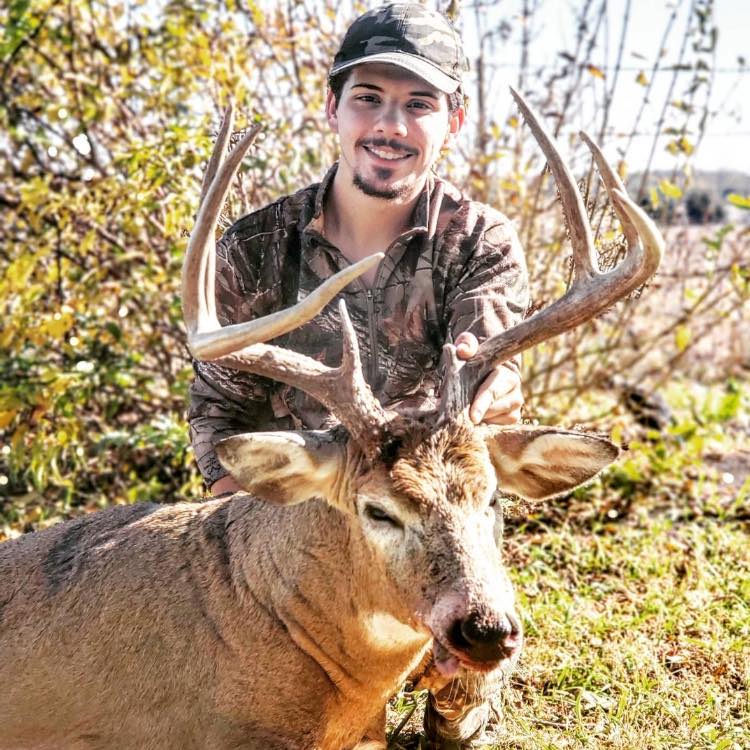
About The Author:
Lake Streeter, A Gun enthusiast, and loves to hunt in the middle of the wood. Always check the latest hunting gears out in the market and try to share his honest opinion with the audience in Hunting Nook.
